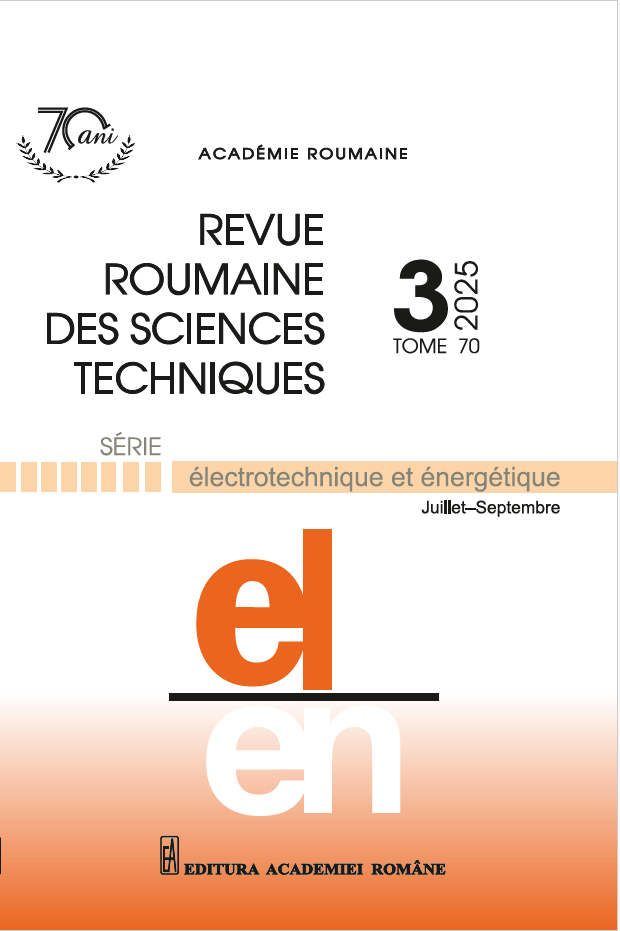EFFECT OF SUPERIMPOSED DC AND AC ELECTRIC FIELDS ON WATER VAPOR CONDENSATION IN A CORONA REACTOR
DOI:
https://doi.org/10.59277/RRST-EE.2025.3.20Keywords:
Humidity control, Corona discharge reactor, DC and AC electric fieldsAbstract
Humidity control in various rooms or installations, whether small or large, is a constant concern. Heat exchangers are generally used whose temperature is maintained below the dew point. Thus, water vapor condenses on the surface of these cooled elements, and the water can be extracted in liquid form. Energy efficiency and effective control of these installations are two critical aspects that are of constant interest in practical applications. This paper presents an experimental study on the condensation efficiency of water vapor in a cylindrical reactor with controlled temperature and corona discharges obtained with a wire electrode positioned on its central axis and supplied with a continuous positive or negative electric voltage. Thus, as a first step, the influence of corona discharges and the DC electric field on the efficiency of water vapor condensation is investigated. Secondly, the experimental study also explores the impact of an AC field superimposed over the DC field corresponding to the corona discharge. The obtained results indicate that the application of the AC electric field superimposed over the DC corona field significantly improves the condensation efficiency of water vapor.
References
(1) L.B Loeb, Electrical Coronas - Their basic physical mechanisms, University of California Press, pp. 15-266 (1965).
(2) K.R. Parker, Applied Electrostatic precipitation, Chapman & Hall, pp. 25–88 (1997).
(3) H.J. White, Industrial electrostatic precipitation, Wesley Publishing Company, Inc., (1963).
(4) D. Blanchard D, L.M. Dumitran, P. Atten, Electroaerodynamic secondary Flow in an electrostatic precipitator and its influence on transport of small diameter particles, Proc. 8th International Conference on Electrostatic Precipitation, Birmingham, paper A1-4 (2001).
(5) L.M. Dumitran, L.V.Badicu, M. Plopeanu, L. Dascalescu, Efficiency of dual wire-cylinder electrodes used in electrostatic separators, Revue Roumaine Des Sciences Techniques-Serie Electrotechnique Et Energetique, 55, 2, pp.171–180 (2010).
(6) J. Bohm, Electrostatic precipitators. Elsevier, pp. 11–366 (1982).
(7) O.C. Ralston, Electrostatic separation of mixed granular materials, Elsevier (1961).
(8) G.H. Douma, J. van Turnhout, P.H. Ong, A study of the electrostatic powder-coating process by charge and current measurements, Inst. of Physics Conf. Ser. 27, pp. 188-201 (1975).
(9) A. Catinean, L. Dascalescu, M. Lungu, L.M. Dumitran, A. Samuila, Improving the recovery of copper from electric cable waste derived from automotive industry by corona-electrostatic separation, Particulate Science and Technology, 39, 4, pp. 449–456 (2021).
(10) M. Reznikov, M. Salazar, M. Rivera – Sustache, M. Lopez, Electrically enhanced harvesting of water vapor from the air, Proc. ESA Annual Meeting on Electrostatics, USA, pp. 1-6 (2015).
(11) M. Salazar, K. Minakata, M. Reznikov, Electrostatic enforcement of steam power plant, IEEE IAS Annual Meeting, USA, pp. 1-5 (2016).
(12) S.A. Vasiliu, L.C. Popescu, A. Stanescu, L.M. Dumitran, Efficiency of water extraction in an electrostatic wire-cylinder system, Int. Symposium on Fundamentals of Electrical Engineering ISFEE Bucharest, Romania (2023).
(13) L.M. Dumitran, C.D. Oancea, G.E. Dumitran, Experimental study of air dehumidification in an electrostatic wire-cylinder condenser, 10th International Symposium on Advanced Topics in Electrical Engineering, Bucharest, Romania, pp. 440-433 (2017).
(14) P. Birbarah, Z. Li, A. Pauls, N. Miljkovic, A comprehensive model of electric‑field‑enhanced jumping‑droplet condensation on superhydrophobic surfaces, Langmuir Journal, 31, 28, pp.7885–7896 (2015).
(15) M.-K. Kim, H. Cha, N. Miljkovic, E.N. Wang, Enhanced jumping droplet departure, Langmuir Journal, 34, 5, pp. 2048–2058 (2018).
(16) P.G. Debenedetti, Metastable Liquids: Concepts and Principles, Princeton University Press (1996).
(17) H. Vehkamäki, Classical Nucleation theory in multicomponent systems, Springer (2006).
(18) A.H. Biermann, Homogeneous nucleation of water vapor in inert gas atmospheres, Doctoral Dissertation, Missouri Univ. of. Science and Technology, USA (1971).
(19) A.I. Rusanov, Thermodynamic theory of nucleation on charged particles, J. of Colloid and Interface Science, 68, pp. 32-47 (1979).
(20) V.B. Warshavsky, A.K. Shchekin, The effects of external electric field in thermodynamics of formation of dielectric droplet, Colloids and Surfaces A: Physicochemical and Engineering Aspects, 148, 3, pp. 283-290 (1999).
(21) A.K. Shchekin, T.S. Podguzova, The modified Thomson equation in the theory of heterogeneous vapor nucleation on charged solid particles, Atmospheric Research, 101, pp. 493-502 (2012).
(22) M. Pauthenier, M. Moreau-Hanot, La charge des particules sphériques dans un champ ionisé, Journal de Physique et le Radium, 3, pp. 590-613 (1932).
(23) A. Niewulis, J. Podlinski, A. Berendt, J. Mizerazcyc, Influence of electrode geometric arrangement on the operation of narrow circular electrostatic precipitator, Int. J. of Plasma Environmental Science & Technology, 8, 1, pp. 60-71 (2014).
Downloads
Published
Issue
Section
License
Copyright (c) 2025 REVUE ROUMAINE DES SCIENCES TECHNIQUES — SÉRIE ÉLECTROTECHNIQUE ET ÉNERGÉTIQUE

This work is licensed under a Creative Commons Attribution-NonCommercial-NoDerivatives 4.0 International License.


